ArtSmart Roundtable – Medieval Europe at the Cloisters, New York City
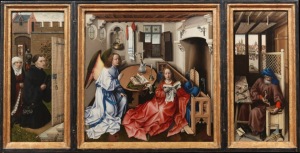
The monthly ArtSmart Roundtable brings together some of the best art history-focused travel blogs with a post on a common theme. For March we are discussing Art Worth Traveling For. You can find links below to all the group’s amazing destinations this month. We also want to welcome the Roundtable’s newest member, Murissa from The Wanderfull Traveler!
I love medieval art and architecture. In the back of my mind, I have the perfect medieval art itinerary planned: starting among the great Cathedrals of France, I move south through the Pyrenees into Spain and enjoy all the pilgrimage churches along the Camino de Santiago de Compostela. Someday I’ll do all of this! But in the meantime, for an infusion of Medieval art without leaving the US, I have to recommend a visit to the hauntingly beautiful Cloisters Museum in New York City. Going far beyond the normal concept of a museum, the Cloisters recreates the atmosphere of a medieval monastery by literally transporting parts from Europe and reconstructing them in Northern Manhattan.
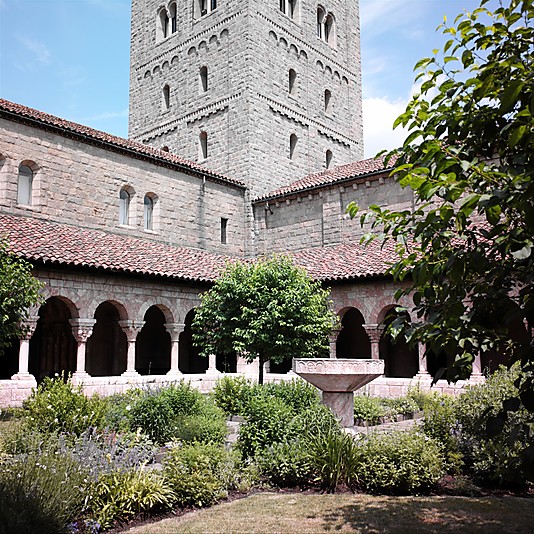
The Cloister from Saint-Michel-de-Cuxa, (ca. 1130–40) as can be viewed at the Cloisters Museum in New York City. This structure is Catalan in style but is from present day France. (Photo: The Cloisters Collection)
The Cloisters museum itself, decorative elements, objects on display and the adjacent park were donated to the Metropolitan Museum by John D. Rockefeller in the late 1930’s and include pieces from his own collection and other collections purchased specifically for this project. The building incorporates major architectural elements from 5 French Medieval monasteries: Saint-Michel-de-Cuxa (12th century, Pyrenees), Saint-Guilhem-le-Désert (late 12th century, Languedoc region), Bonnefont-en-Comminges (late 13th century, Burgundy region), Froville (15th century, Lorraine region) and Trie-en-Bigorre (late 15th century, Gascony region). Before you begin to think that it’s cruel to remove these structures, many had fallen into disrepair in the last century. One was even being used as a barn when it was purchased and shipped to New York! At least in the US, countless visitors can enjoy these medieval spaces and their preservation is ensured.
The artistic completeness of the Cloisters is incredible. I visited several years ago for a conference reception and had the pleasure of exploring the museum after the opening hours. Wandering the empty stone halls, it felt like being in France in an abandoned monastery. Moving from one complete and artistically engulfing room to another was like time travel as I stepped from 11th century France to the 13th century and so on.
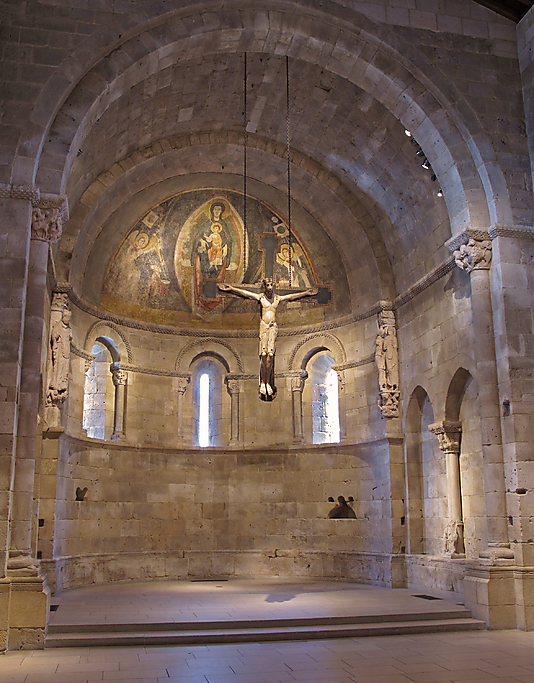
One small chapel in the Cloisters consists of the “Apse from San Martín at Fuentidueña” (ca. 1175–1200) originally from Segovia, Spain. (Photo: The Cloisters Collection)

The “Chapter House from Notre-Dame-de-Pontaut” from Bordeaux was constructed in the 12th century. (Photo: The Cloisters Collection)
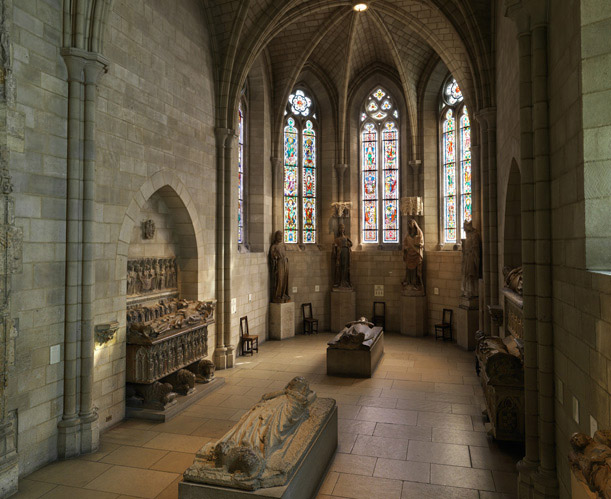
This 13th century “Gothic Chapel” displays beautiful stained glass and royal burial effigies. (Photo: The Cloisters Collection)
While the architecture comes from specific monasteries, the objects on display in the Cloisters come from throughout Medieval Europe and are grouped by time period. As a result, you get very strong gallery by gallery collections marking the stylistic changes in an otherwise broad period of art history. It’s refreshing to see some delineation within the realm of “medieval art”.
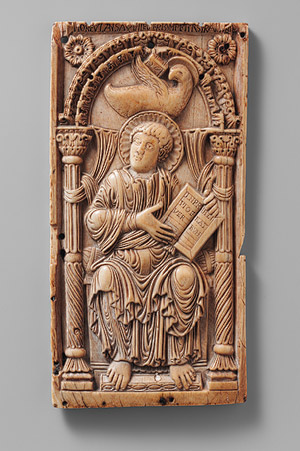
An example of early Carolingian art made on elephant ivory, “Plaque with Saint John the Evangelist”, early 9th century, Aachen, Germany. (Photo: The Cloisters Collection)

“Virgin” from Strasbourg, France, ca. 1250, painted limestone. At 1.5m tall, this statue originally decorated a choir screen. (Photo: The Cloisters Collection)
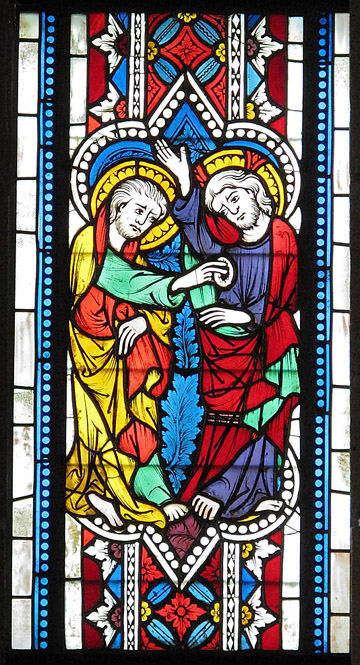
“Doubting Thomas” Stained Glass, ca. 1340–50, from the church of St. Leonhard, Lavanttal, Austria. (Photo: The Cloisters Collection)
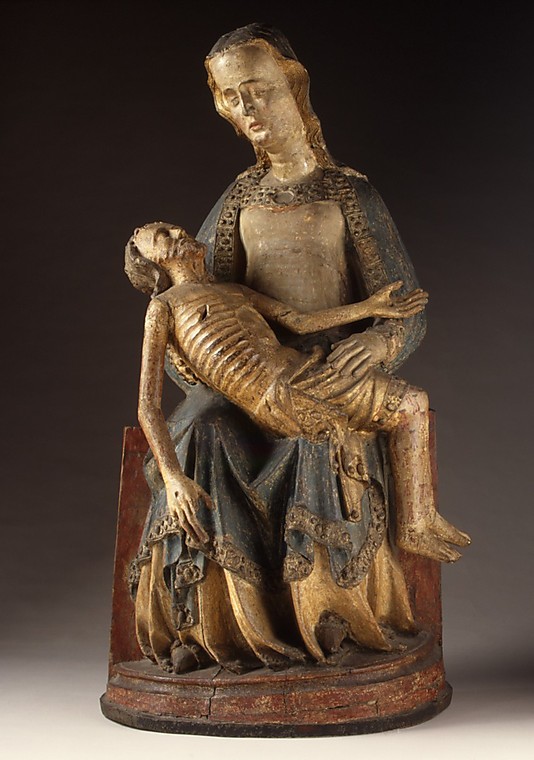
“Pietà” from the Rhine Valley, Germany, ca. 1375-1400. This emotional, devotional statue is made of wood and painted plaster. (Photo: The Cloisters Collection)
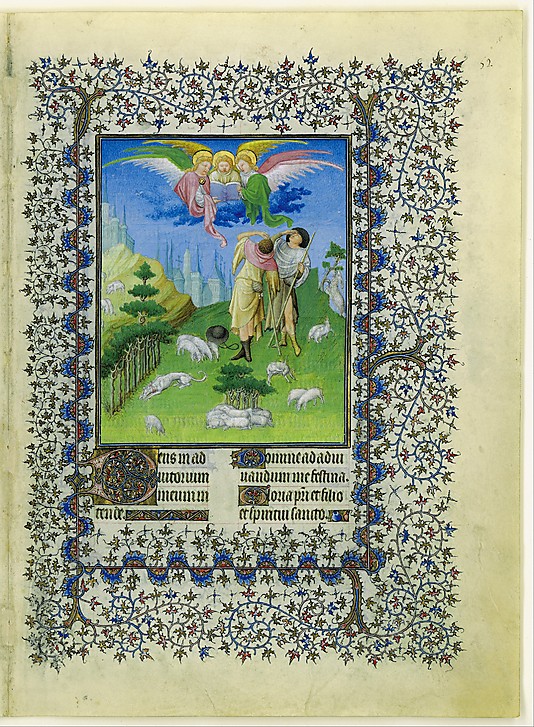
Herman, Paul, and Jean de Limbourg, “Annunciation to the Shepherds” from The Belles Heures of Jean de France, Duc de Berry, illuminated manuscript, ca. 1405-1409, Paris, France. (Photo: The Cloisters Collection)
The most breath-taking piece in the entire collection was the Mérode Altarpiece by Robert Campin (and assistants). Lit by spotlights in a dim room, the colors glowed when I visited the piece. I was awed by the detail and the perfection in execution of this oil painting. The stone room in which the painting is displayed is decorated with domestic objects reminding viewers that this compact masterpiece was originally mean for private devotion.
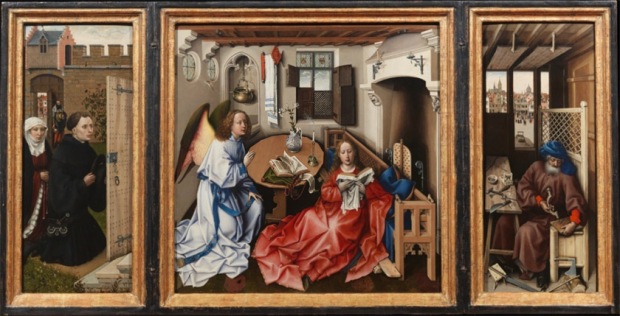
Robert Campin and workshop, “Annunciation Triptych (Merode Altarpiece)”, 1427–32 (Photo: The Cloisters Collection)
The famous Unicorn Tapestries are a must-see for every visitor. Woven in Brussels from French designs, these seven tapestries depict the hunting and capture of a mythic unicorn believed to have magically healing powers. The brilliant, colorful images are lush with plants and flowers. While the hunt scenes contain Christian themes, the unique “Unicorn in Captivity” tapestry alludes to marriage and fertility with its symbolic plants and flowers. Behind a small fence and tethered with a thin chain, the smiling unicorn seems too contented to try to escape.
While there are many amazing things to do and see in New York City, none may transport you in the same way as a visit to the Cloisters Museum. While it does require an hour long bus ride from downtown Manhattan, the Cloisters is a lovely, peaceful and incredibly beautiful art destination well worth the travel. And if anything, it is a bit closer to home than Southern France.
For the rest of the March ArtSmart Roundtable, see:
- Lesley Peterson of Culture Tripper: The power and the glory of San Vitale, Ravenna
- Kelly of Travellious: Richard Serra’s Band Sculpture
- Jenna of This is My Happiness: Art Exhibits in 2013: Art Worth Traveling For
- Erin of A Sense of Place: Wait, You Want Me to Go to Liverpool to See Art?
- Murissa of The Wanderfull Traveler: Art Worth Traveling For in Rural Italy
- Jeff of Eurotravelogue: Traveling for the Love of Art
And don’t forget to “like” our group on Facebook for art & travel news!
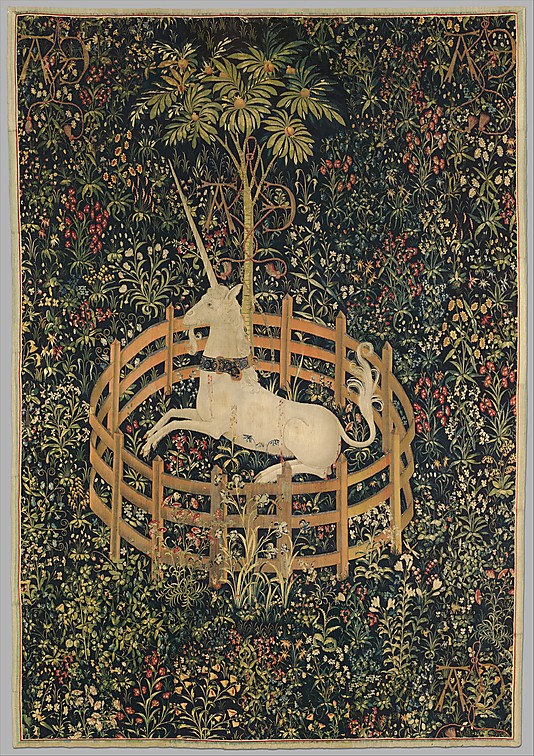





I’ve always meant to visit there. It looks so lovely, I will have to be sure to make it up on my next trip!
LikeLike
I saw this on an episode of Museum Secrets.
It also houses a Dooms Day book about what one should expect on the day of.
Such a grand gesture to have even reassembled this place in North America.
Quite an inspiration.
LikeLike
Thanks Murissa! I still can’t believe people in the 1920’s actually “collected” entire rooms of architecture. To create the Cloisters, Rockefeller to some extend just assembled rooms he purchased from another collector.
LikeLike
Atmospheric post, Christina! You’ve inspired me to take that one-hour bus ride the next time I’m in NYC. I’ve long wanted to see the unicorn tapestries but the tomb effigies and the garden look amazing, too.
LikeLike
Thanks Lesley! I hope you make it to NYC soon 🙂
LikeLike
Gah! I have to hang my medievalist head in shame that I haven’t been here. I wanted to go the last time I was NYC, but I didn’t have the time.
I’ve wanted to go since seeing photos in my mom’s art history book as a kid. After Paris, this trip needs to be on the priority list.
LikeLike
Clearly Paris is the priority! Now you just have an excuse for a long weekend to NYC when the park around the Cloisters is in full bloom. 🙂
LikeLike
Like the others, I also have not been there and would love to go. I love medieval architecture. This is an amazing collection and a great way for Americans or NYC visitors to learn about European history and art, but I’m not sure how I feel about the fact that the chapels are no longer where they were originally meant to be.
LikeLike
Thanks Jenna. While I appreciate the chance to experience real medieval architecture in NYC, I also struggled with the relocation of these pieces. While we would never transport whole structures today, this was considered acceptable a century ago. (Some would consider the Egyptian, Greek and Mesopotamian wings in London and Paris to be equally stolen!) On some level, all paintings, statues and artifacts that have been removed from their native regions should be as startling but we are use to seeing this and treating these objects as commodities. By comparison it just seems more shocking to see a large portion of a building removed. My understanding is that local owners were paid for this architecture, much like buying a painting.
My consolation is that these structures may actually be better preserved as part of the Cloisters than if left in their respective cities and it allows a lot more visitors to appreciate the art than would otherwise have seen it.
LikeLike
I’m embarrassed to say I lived not 20 blocks from The Cloisters and never made it. Kept promising to. Thanks for the post. I’ve put it on my list for my next trip to NYC.
LikeLike
Thanks for your comment, I didn’t mean to make you feel guilty! 😉 I hope you get to the Cloisters soon!
LikeLike
I lived in NYC for only 2 years, but visited the Cloisters at least once per month. The entire park surrounding it is also a wonderful place that transports one out of the hustle and bustle of the city, much more than central park. (http://www.nycgovparks.org/parks/forttryonpark)
Sadly, I have not been to the Cloisters for a decade and greatly miss the calming peacefulness of the setting. Time to look at ticket sales to NYC! Thanks for the memories and inspiration.
-Sara
LikeLike
I never knew there was a Cloister museum, how peculiar.
I’m used to seeing cloisters in Europe with pieces such as pillars brought back as treasure from Italian victories against the Greeks, and further afield, from modern day Turkey, but seeing a whole piece of history moved on such a scale is incredibly new and surprising to me.
LikeLike